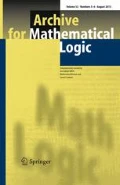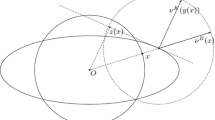Abstract
In the informal setting of Bishop-style constructive reverse mathematics we discuss the connection between the antithesis of Specker’s theorem, Ishihara’s principle BD-N, and various types of equicontinuity. In particular, we prove that the implication from pointwise equicontinuity to uniform sequential equicontinuity is equivalent to the antithesis of Specker’s theorem; and that, for a family of functions on a separable metric space, the implication from uniform sequential equicontinuity to uniform equicontinuity is equivalent to BD-N.
Similar content being viewed by others
References
Aczel, P., Rathjen, M.J.: Notes on constructive set theory, Report No. 40. Institut Mittag–Leffler, Royal Swedish Academy of Sciences (2001)
Bishop, E.A., Bridges, D.S.: Constructive analysis, Grundlehren der Math. Wiss. 279. Springer-Verlag, Heidelberg (1985)
Berger, J.: A separation result for varieties of Brouwer’s fan theorem. University of Munich, (2009, preprint)
Berger J., Bridges D.S.: A fan-theoretic equivalent of the antithesis of Specker’s theorem. Indag. Math. N.S. 18(2), 195–202 (2007)
Berger J., Bridges D.S.: The anti-Specker property, a Heine–Borel property, and uniform continuity. Arch. Math. Logic 46(7–8), 583–592 (2008)
Bridges, D.S.: Omniscience, sequential compactness, and the anti-Specker property (2009, submitted)
Bridges D.S., Diener H.: The pseudocompactness of [0, 1] is equivalent to the uniform continuity theorem. J. Symb. Logic 72(4), 1379–1383 (2007)
Bridges, D.S., Diener, H.: The anti-Specker property, positivity, and total boundedness. University of Canterbury (2009, preprint)
Bridges D.S., Richman F.: Varieties of Constructive Mathematics, London Mathematical Society Lecture Notes 97. Cambridge University Press, Cambridge (1987)
Bridges, D.S., Vîţă, L.S.: Techniques of Constructive Analysis. Universitext, Springer, New York (2006)
Bridges D.S., Ishihara H., Schuster P.M., Vîţă L.S.: Strong continuity implies uniform sequential continuity. Arch. Math. Logic 44, 887–895 (2005)
de Swart H.: Elements of intuitionistic analysis; the stone-weierstrass theorem and Ascoli’s theorem. Zeit. Math. Logik und Gründlagen Math. 22, 501–508 (1976)
Diener, H.: Compactness under constructive scrutiny. Ph.D. thesis, University of Canterbury (2008)
Diener H., Loeb I.: Sequences of real functions on [0, 1] in constructive reverse mathematics. Ann Pure Appl. Logic 157, 50–61 (2009)
Dieudonné J.A.: Foundations of Modern Analysis. Academic Press, New York (1960)
Friedman H.M.: Set Theoretic foundations for constructive analysis. Ann. Math. 105(1), 1–28 (1977)
Ishihara H.: Continuity properties in constructive mathematics. J. Symb. Logic 57, 557–565 (1992)
Ishihara H.: Sequential continuity in constructive mathematics. In: Calude, C.S., Dinneen, M.J., Sburlan, S.(eds) Combinatorics, Computability and Logic, pp. 5–12. Springer, London (2004)
Ishihara H., Yoshida S.: A constructive look at the completeness of \({\mathcal{D}({\bf R})}\) . J. Symb. Logic 67, 1511–1519 (2002)
Ishihara H.: Reverse mathematics in Bishop’s constructive mathematics. Phil. Sci. Cahier Special 6, 43–59 (2006)
Lietz, P.: From constructive mathematics to computable analysis via the realizability interpretation. Ph.D. Thesis, Technische Universität, Darmstadt, Germany (2004)
Loeb I.: Equivalents of the (weak) fan theorem. Ann. Pure Appl. Logic 132, 51–66 (2005)
Myhill J.: Constructive set theory. J. Symb. Logic 40(3), 347–382 (1975)
Simpson, S.G.: Subsystems of Second Order Arithmetic (2nd edn.). Perspectives in logic, association for symbolic logic. (2007, to appear)
Specker E.: Nicht konstruktiv beweisbare Sätze der analysis. J. Symb. Logic 14, 145–158 (1949)
Author information
Authors and Affiliations
Corresponding author
Rights and permissions
About this article
Cite this article
Bridges, D.S. Constructive notions of equicontinuity. Arch. Math. Logic 48, 437–448 (2009). https://doi.org/10.1007/s00153-009-0131-9
Received:
Revised:
Published:
Issue Date:
DOI: https://doi.org/10.1007/s00153-009-0131-9




